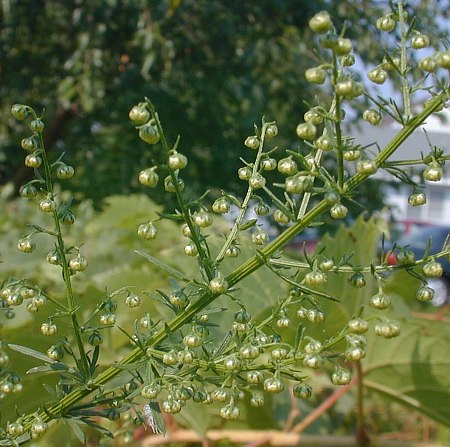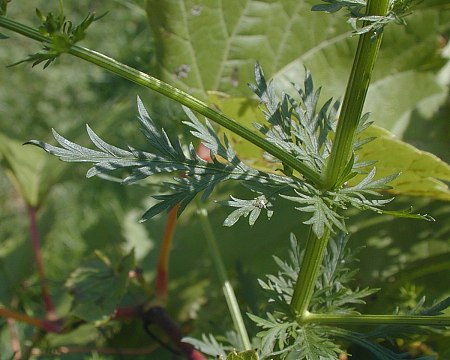Description: This plant is a summer annual about 3-6' tall; it is more or less erect and branches regularly. The light green stems are angular-terete, ridged, and hairless; the secondary stems are ascending or spreading. The alternate leaves are up to 6" long and 4" across, becoming smaller as they ascend the stems. They are green and hairless. Each leaf is pinnately divided (double or triple) into slender lobes that are narrowly lanceolate or oblong-lanceolate; some of these lobes are cleft or toothed along their margins. The lower leaves have petioles, while the upper leaves are sessile.

The upper stems
terminate in floral panicles up to 1½' long and half as much across.
The panicles are abundantly branched, each branch consisting of a
raceme of small drooping flowerheads. about 1-2 mm. across (1/8" or
less). Each flowerhead is about 2 mm. across (1/8" or less); it has
many tiny disk florets. At the base of each flowerhead, there are 6
oblong bracts that are dark green. The blooming period occurs from late
summer into the fall. There is no floral scent, although the foliage
has a sweet fruity fragrance. Pollination is by wind. Upon maturity,
each floret is replaced by a single achene. These achenes are small
enough to be carried aloft by the wind, even though they lack tufts of
hair. The root system consists of a branching taproot. This plant
reproduces by reseeding itself.
Cultivation:
The preference is full or partial sun, moist to mesic conditions, and
fertile loamy soil with high nitrogen content. This plant also adapts
to gravelly and sandy soil.
Range & Habitat:
Annual Wormwood is occasional throughout Illinois (see Distribution
Map). It was introduced from Eurasia as a medicinal herb.
Escaped plants usually don't persist in a given location. Habitats
include woodland borders, low-lying areas along rivers and ponds,
fields, vacant lots, edges of yards, fence rows, gardens, back alleys
in older cities, and areas along railroads and roadsides. Disturbed
habitats are preferred. Annual Wormwood is still cultivated
occasionally in gardens.

Faunal
Associations:
The wind-pollinated florets attract few insects, while the seeds are
too small to be of much value to birds. Mammalian herbivores usually
avoid consumption of Artemisia spp. (Wormwoods)
because of the bitter compounds and mild to moderate toxicity of their
foliage.
Photographic Location:
Along a fence row in Urbana, Illinois. The flowerheads in the upper
photograph are still in the bud stage.
Comments:
Another common name for this plant is 'Sweet Annie.' Annual Wormwood is
a non-woody summer annual that has hairless foliage with a sweet fruity
fragrance. Other Artemisia spp. (Wormwoods) are
often herbaceous biennials or woody perennials with hairy foliage (at
least on the underside of their leaves). Many of these species have
foliage with a smoky fragrance that resembles the seasoning 'Sage.'
Annual Wormwood differs from a similar species, Artemisia
biennis (Biennial Wormwood), by its double or triple pinnate
leaves and spreading floral panicles. The latter species has simple
pinnate leaves and a more spike-like inflorescence. The foliage of
Annual Wormwood contains a chemical that is useful in the treatment of
malaria.